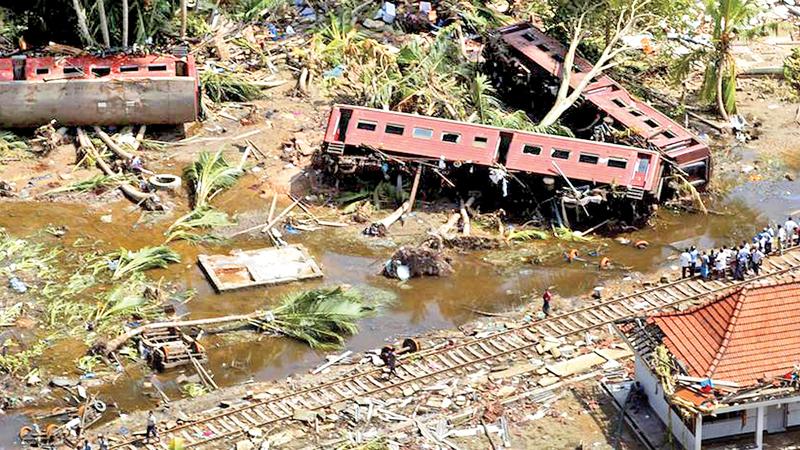
It was a sunny afternoon when the tipper truck loaded with decomposed corpses pulled up at the tiny cemetery in Watugedera, Ambalangoda.
None of the dead could be identified since the corpses were in a highly decomposed condition and the gender of the victims could be traced by the clothing while children by the size.
The victims were passengers in the Matara bound train that had left the Maradana Railway Station at the crack of dawn on December 26, 2004.
The exact figure of passengers on the ill-fated train could never be reached but it was believed to be around 2,000 men, women and children most of them intending to visit relatives and friends in the South during the festive season.
Unaware to those inside the train an earthquake measuring 7.8 on the Richter scale struck the sea bed on the Sumatra coast in Indonesia triggering massive tidal waves that crashed onto the shores in several countries.
Huge waves
Sri Lanka was right in the middle of the quake’s path and waves measuring some 40 metres in height lashed several coastal districts in the country from the South to the East and from the West to the North leaving thousands dead and a trail of destruction.
 On this day the ill-fated train had left the Ambalangoda Railway Station with the crew unaware of the looming danger just a kilometre away.
On this day the ill-fated train had left the Ambalangoda Railway Station with the crew unaware of the looming danger just a kilometre away.
At Peraliya, which is a few metres away from the seashore a wall of water crashed onto the train with a ferocious force throwing the engine and carriages off the track while trapping those inside and in a few moments most of them were dead. There were very few survivors.
On this day the writer was visiting a friend in Ambalangoda.
The previous day was Christmas and the revelry went on late into the night and I was fast asleep only to be rudely woken by an anxious household with fright written all over their faces.
Soon news bulletins on radio and TV were giving us the grim news of the tsunami and the devastation it caused. What was even more frightening is that experts were predicting more aftershocks-meaning more killer waves to crash onto land.
On reaching the Galle Road in Ambalangoda which was some two kilometers from where I was staying along with my friend we were confronted by a ghostly scene.
The tarred Galle Road was covered with sea sand and shells while houses and buildings that were there the previous day had been completely destroyed or washed away into the ocean.
An eerie silence prevailed in the area. The people were too shocked and terrified to scream and a short while later the chaos began.
Mad rush
People clutching babies and a few belongings were bolting in a mad rush to higher ground fearing more waves that had been predicted by weather experts and others.
However, there were no more waves and the following day the search began for missing family members, loved ones and friends while the body count began to tick on at a rapid pace.
On reaching the site of the Peraliya train tragedy hundreds of dead could be seen from the road while the police and security forces along with volunteers had taken up positions to retrieve the bodies.
It was an uphill task and it took more than three days to remove the dead from the train and they were all highly decomposed and beyond identification.
Sri Lanka recorded the second highest number of deaths, 35,322 after Indonesia which had 130,736 fatalities.
What was even more saddening is that the bulk of the passengers were from other parts of the country and they were buried in unmarked graves in borrowed cemeteries as was the case in Watugedera.
As we celebrate Boxing Day let us spare a thought for all those who perished on that fateful December 26, 17 years ago and it is hoped that such a tragedy will never happen again.
